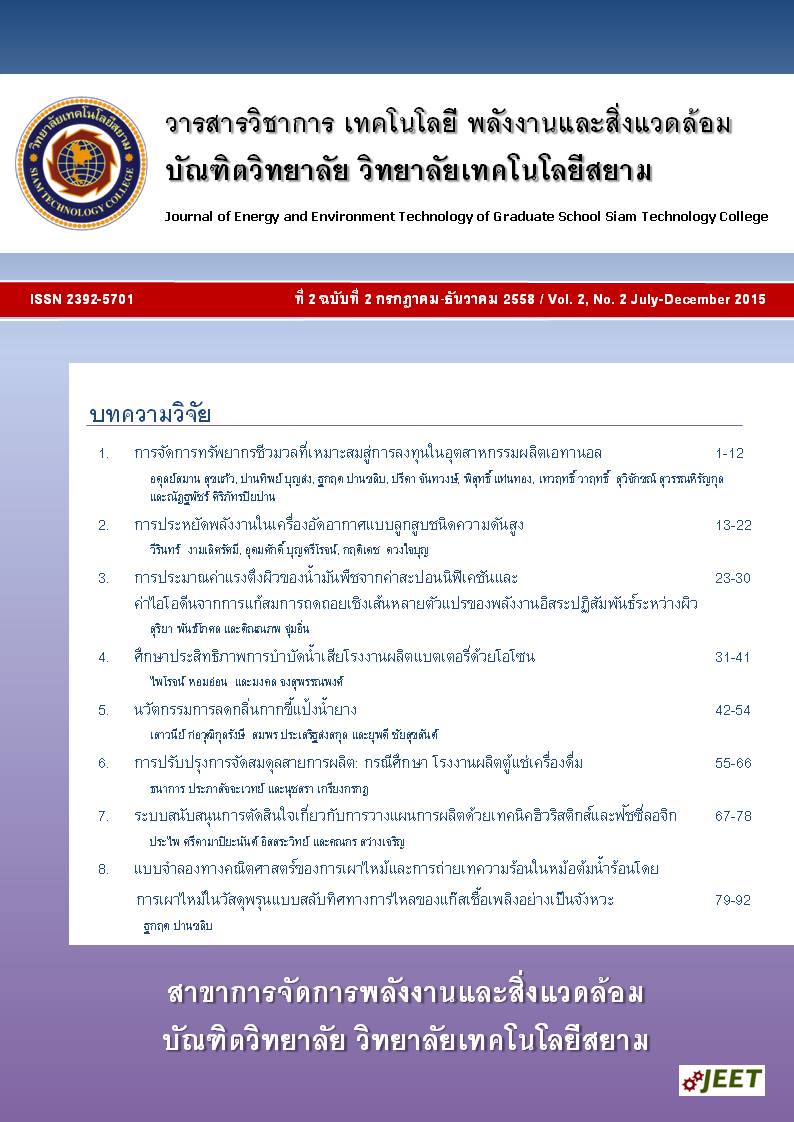The Innovative reduction odor of Latex Sludge
Main Article Content
Abstract
Sludge was waste generated from concentrated latex manufactory by centrifuging. It composes of some coagulated rubber, insoluble material of magnesium ammonium phosphate (MgNH4PO4.6H2O). Particularly, fresh latex preserved with ammonia is contained. This precipitated salt sometimes containing occluded rubber. The sludge is deposited in the bowl. It was settled in the bottom of the container during storage and deposits in the bowl of the centrifuged containers. Generally, this disposed latex sludge was become waste, abandoned, reclamation and incineration. The odor of dried storage was foul. It was useless. This research was worked on properties of latex sludge, extended effective microorganisms (EM), reduction odor of latex sludge and evaluation of effective microorganisms as foul odor in latex sludge.
Article Details
เนื้อหาและข่อมูลในบทความที่ลงตีพิมพ์ในวารสารวิชาการ เทคโนโลยี พลังงาน และสิ่งแวดล้อม บัณฑิตวิทยาลัย วิทยาลัยเทคโนโลยีสยาม ถือเป็นข้อคิดเห็นและความรับผิดชอบของผู้เขียนบทความโดยตรง ซึ่งกองบรรณาธิการวารสารไม่จำเป็นต้องเห็นด้วย หรือว่าร่วมรับผิดชอบใด ๆ
บทความ ข้อมูล เนื้อหา รูปภาพ ฯลฯ ที่ได้รับการตีพิมพ์ในวารสารวิชาการ เทคโนโลยี พลังงาน และสิ่งแวดล้อม บัณฑิตวิทยาลัย วิทยาลัยเทคโนโลยีสยาม ถือเป็นลิขสิทธิ์ของวารสารวิชาการ เทคโนโลยี พลังงาน และสิ่งแวดล้อม บัณฑิตวิทยาลัย วิทยาลัยเทคโนโลยีสยาม หากบุคคล หรือหน่วยงานใดต้องการนำทั้งหมด หรือส่วนหนึ่งส่วนใดไปเผยแพร่ต่อ หรือเพื่อกระทำการใด ๆ จะต้องได้รับอนุญาต เป็นลายลักษณ์อักษรจากวารสารวิชาการ เทคโนโลยี พลังงาน และสิ่งแวดล้อม บัณฑิตวิทยาลัย วิทยาลัยเทคโนโลยีสยาม เท่านั้น
References
[2] สถาบันวิจัยวิทยาศาสตร์และเทคโนโลยีแห่งประเทศไทย. (2544). ธาตุอาหารพืช [ระบบออนไลน์]. แหล่งที่มา URL : :http://www. tistr.or.th เข้าดูเมื่อวันที่ 10 สิงหาคม 2557.
[3] Khaliq, A., Abbasi M. K. and Hussain, T. (2006). Effects of integrated use of organic and inorganic nutrient sources with effective microorganisms (EM) on seed cotton yield in Pakistan. Bioresource Technology, 97 : 967-972.
[4] บริษัท อี เอ็ม คิวเซ จำกัด. (2546). EM [ระบบออนไลน์]. แหล่งที่มา URL : http:/www.emkyusei.com. เข้าดูเมื่อวันที่ 2 สิงหาคม 2556.
[5] AOAC. (2000). Official methods of the association of official analytical chemists, 15thedition, AOAC, Washington D.C., U.S.A.
[6] ภาณุพงศ์ บางรักษ์. (2548). การทำปุ๋ยหมักจากวัสดุเศษเหลือโรงงานสกัดน้ำมันปาล์มผสมน้ำหมักของ Rhodobacter capsulatus SS3 และการใช้ในการปลูกผักบุ้งและต้นหอม. วิทยานิพนธ์วิทยาศาสตรมหาบัณฑิต สาขาเทคโนโลยีชีวภาพ คณะวิทยาศาสตร์ มหาวิทยาลัยสงขลานครินทร์.


